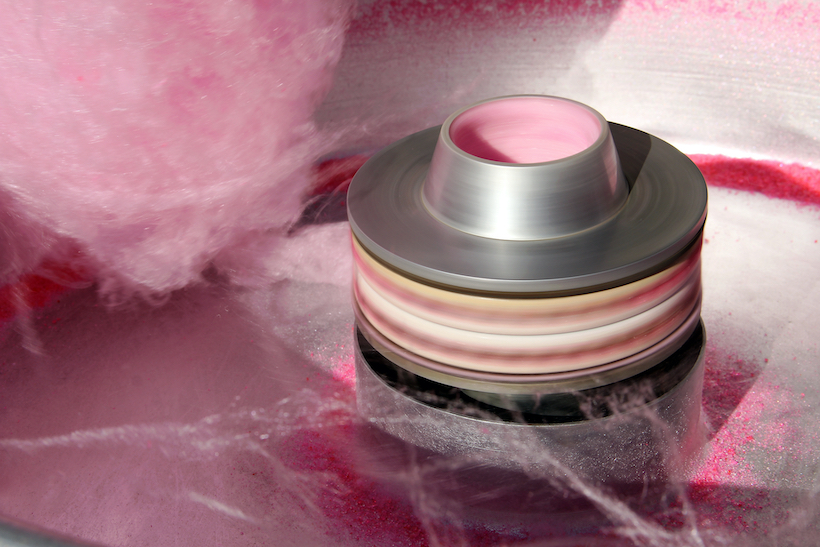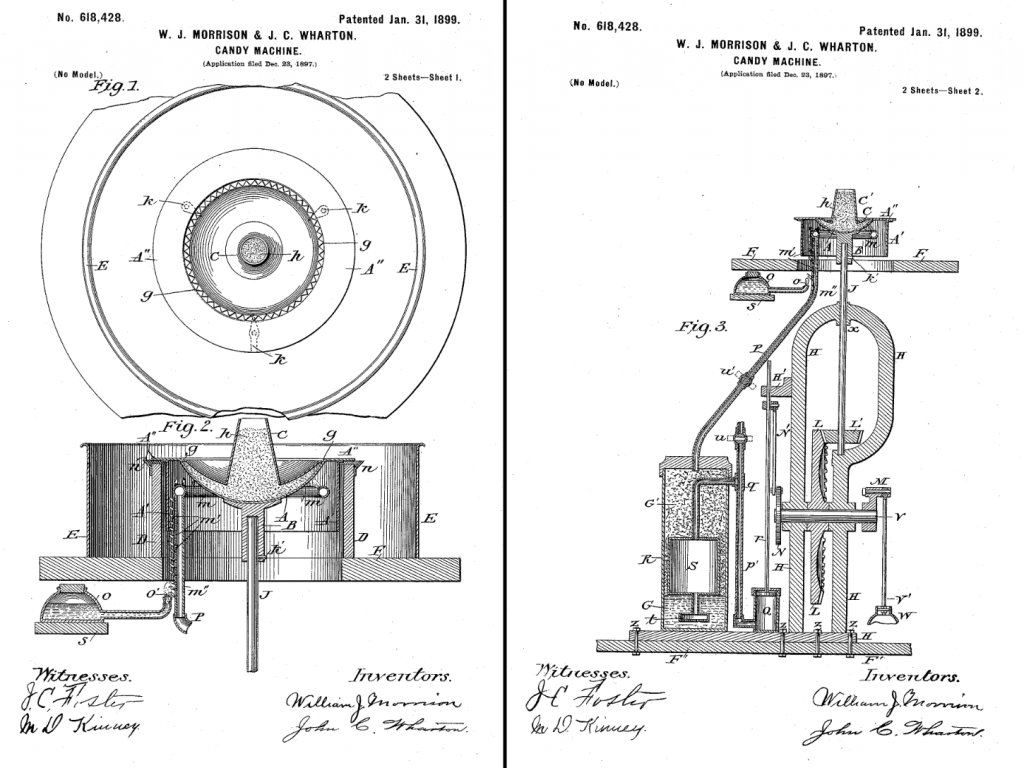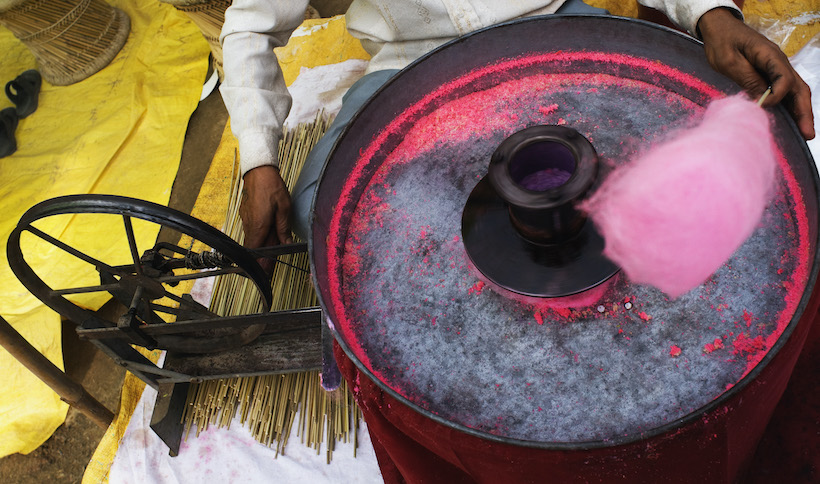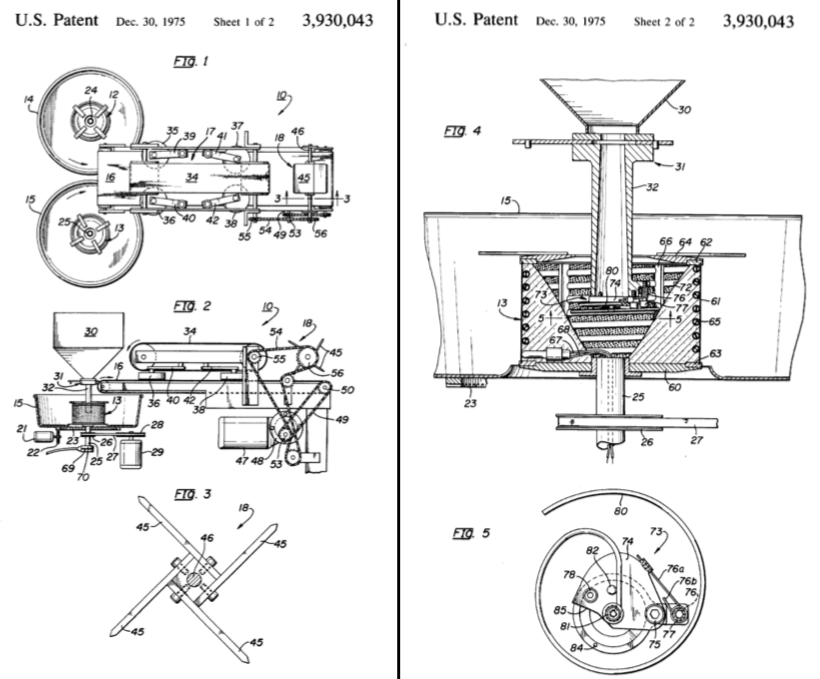When I was younger, I loved eating cotton candy at the fair or on (rare) trips to amusement parks. Cotton candy always seemed like the perfect snack for walking around a hot summer day – regardless of how sticky it was (or how it seemed to turn my mouth blue).
Nowadays, I'm too wary of cavities to indulge as much as I used to—which is the great irony of the treat, considering how many dentists played a part in its early days. Oh yes, it's a sweet story... and that's just the beginning.
So: grab yourself some some spun sugar and let's talk about the history of cotton candy.

Cotton candy is essentially very thin spun sugar (even thinner than a human hair).
With cotton candy, sugar is heated up until it melts into a liquid, then spun around at high speeds to force the liquid sugar out a series of small holes. As the sugar liquid spins through these holes, it cools rapidly. The result is a lot of long, skinny "strings" of sugar that clump together on a cone or a stick.
Spun sugar on its own is usually white, but by adding flavors and syrups to the melted sugar, cotton candy makers can create the iconic blue and pink colors we all know and love.
The most important part of a cotton candy maker is the spinning head. A cotton candy machine generally looks like a large, shallow bowl with a small chamber in the middle. The chamber, or head, rests on top of the heating element, which usually needs to be plugged into a power source.
As the heating element liquefies the sugar, the spinning head will begin to rotate rapidly until the centrifugal forces pulling on the melted sugar "spin" the liquid out in long strands. The bowl rotates to keep the sugar from piling up in one place.
The cotton candy maker then takes a stick or paper cone and spools the cotton candy with a quick figure-eight motion of the hand. Once enough of the sugar strands have been collected, the cotton candy maker removes the cone and rolls the remaining strands onto the cone to finish it.
Unsurprisingly – since it is made entirely of sugar with a little bit of food dye or flavorings – cotton candy is very high in sugar. Fortunately, it's mostly air – compared to other "classic fair foods," it's a low-calorie treat.
Overall, a stick of cotton candy is around 110 calories. (Expected more, right?)
Again, cotton candy is made entirely of sugar. This means that the main chemical component is sucrose, which is made up of carbon, hydrogen, and oxygen atoms. When sugar gets hot enough, the bonds between the different molecules break. The hydrogen and oxygen molecules rebind to form water, which quickly evaporates in the heat.
As the carbon heats up, it starts to caramelize into spun sugar. With the hydrogen and oxygen molecules gone, all that's left is the quickly-burning carbon sugar molecules. As these molecules meet "cold" air outside of the spinning head, they cool almost immediately into sugar string.

In 1897, dentist and inventor William Morrison worked with candy-maker John C. Wharton to make the first cotton candy machine.
Morrison was around 37 years old at the time, hailed from Nashville, Tennessee, and had previously filed patents for a wide variety of inventions before the cotton candy machine. Best of all – he would later go on to become the president of the Tennessee State Dental Association.
While Morrison came up with the big idea for the machine, local confectioner John C. Wharton helped him refine his cotton candy maker's design until it was ready for its big (and infamous) debut at the 1904 World's Fair.
The Louisiana Purchase Exposition, more commonly known today as the 1904 St. Louis World's Fair, was a seven-month exposition attended by more than nineteen million people and saw representatives from over sixty countries around the world. Scientific, medical, and cultural advances were put on display for all the world to see, and new and exciting foods jostled for their spot on the stage.
Cotton candy was an instant hit when it debuted at the World's Fair. Morrison and Wharton sold over sixty-eight thousand boxes of "fairy floss" to curious fair-goers, and cotton candy has been a fairground classic ever since.
While Morrison and Wharton are most remembered as the inventors of the cotton candy machine, there have been other claims (or at least, improvements) on the invention. Joseph Lascaux, another dentist(!) from New Orleans, invented a similar machine in 1921. You wouldn't recognize Lascaux's design, but I guarantee he made a mark – Lascaux coined the moniker "cotton candy" for the first time.
An even earlier claim on the cotton candy machine comes from one Thomas Patton. Instead of using a cone or a stick, Patton's design used a fork to comb through the long strands of sugar and create an even mass of the spun confection. Patton's cotton candy machine also used a gas power source instead of electricity to generate the heat required to melt the sugar.
Compared to Morrison and Wharton's patents, the designs submitted by Lascaux and Patton are challenging to find. However, while Patton is a historical footnote, Lascaux had arguably the biggest contribution—he gets 100% credit for the name cotton candy.

As mentioned, Joseph Lascaux was the first to rename what was then commonly known as "fairy floss."
Like Morrison, Lascaux was a dentist and an inventor, although he practiced his trade in New Orleans, Louisiana instead of in Tennessee. Supposedly, he named "cotton candy" after the cotton that grows in Louisiana.
After submitting a patent for his "cotton candy" machine, Lascaux continued to sell this sweet treat out of his dentist's office in New Orleans. While Lascaux himself never became famous for creating his spun-sugar confection, the name that he coined certainly stuck around.
By the late 1920's "cotton candy" had pretty much replaced "fairy floss" in most countries (Australia is the exception).
I mean – have you ever called it fairy floss?
Although it began life as an ink-selling company(!), Gold Medal Products has played an enormous role in the development of cotton candy as we know and love it.
In 1949, Gold Medal Products introduced a spring-loaded base to the now-iconic cotton candy machine design. The base stopped the machines from shaking violently when in use – this significantly increased the reliability and life of the machines, allowing their popularity to spread even further.
In 1951, they produced a machine that automatically rolled those famous cotton candy bases: paper cones.
Gold Medal Products may be the biggest innovator in the cotton candy game, but they certainly aren't the only game-changer. In 1973, the first design for an automated cotton candy machine was introduced, and by 1978 it had entered mainstream use by several large international food companies.

Today, the leading producer of cotton candy for sale in grocery stores is a company you probably know: Tootsie Roll Incorporated. While the first examples of "fairy floss" were sold in boxes, we've come a long way: nowadays, you're more likely to see cotton candy on a cone or in a bag on the shelf at your local grocery store!
While cotton candy is a relatively recent invention, spun sugar has been around for centuries. In Europe, spun-sugar desserts appeared in Italy as early as the 15th century.
Before electric or gas-powered motors, spinning sugar was a long, arduous task that took several hours of careful, deliberate work. As a result, it was often an extremely expensive dessert that was enjoyed only by the wealthy – or by those with plenty of time on their hands.
Some early recipes even include instructions for adding silver and gold dyes to the spun sugar!
Today, National Cotton Candy Day is December 7th. It seems an odd choice for a mostly summertime treat, but lines up with when Morrison and Wharton first submitted their cotton candy invention.
As mentioned earlier, Tootsie Roll Incorporated is now the largest purveyor of prepackaged cotton candy. The two most popular flavors are "pink" and "blue" ("pink vanilla" and "blue raspberry," according to Gold Medal Products).
Gold Medal Products was the first company to create the blue raspberry flavor in 1958, and soon found it to be hit when combined with their cotton candy!

In Iran, pashmak is a type of spun sugar dessert often topped with ground pistachios to provide a unique flavor. In Turkey and Bosnia, pişmaniye is a variant of cotton candy that includes butter-roasted flour for extra stiffness.
In China, Dragon's Beard Candy uses sugary rice flour stretched into long, thin strands to create a similar dessert. Korea similarly makes Kkul-tarae, although Kkul-tarae is sweetened with honey rather than sugar.
In the UK and Singapore, cotton candy is called "candy floss", and in Israel, it's known as "Grandma's Hair."
And in the US? We, of course, call it "cotton candy." However, if you see me at a fair and ask me for "fairy floss," I promise to exchange a knowing nod.
I don't know if I'll ever get over the irony of the early history of cotton candy involving so many dentists. But, dentists and their affinity for floss aside, it's a fascinating history – and one I'm glad I looked into.
So – the next time you're staining your teeth with some blue raspberry flavored cotton candy, think back to this post and the dentists who brought us here.
And of course, enjoy your fairy floss!